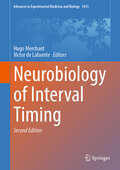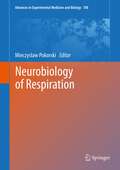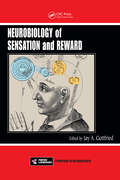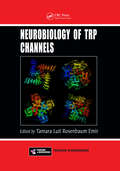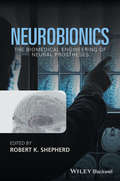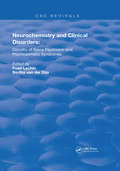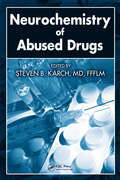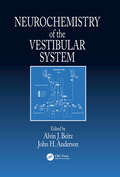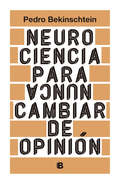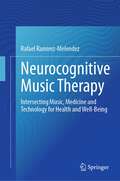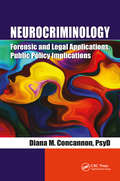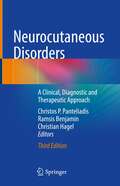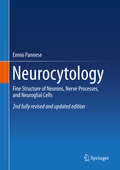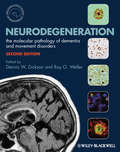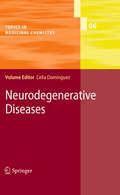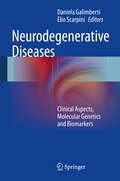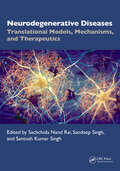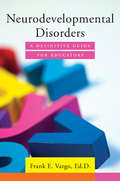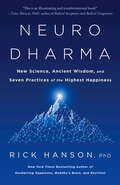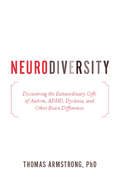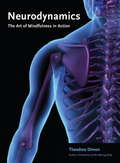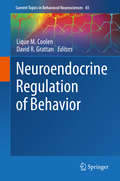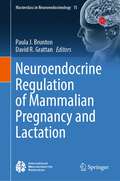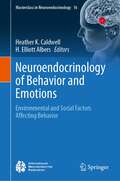- Table View
- List View
Neurobiology of Interval Timing (Advances in Experimental Medicine and Biology #1455)
by Hugo Merchant Victor De LafuenteThe study of how the brain processes time is becoming one of the most important topics in systems, cellular, computational, and cognitive neuroscience, as well as in the physiologic bases of music and language. During the last and current decade, interval timing has been intensively studied in humans and animals using increasingly sophisticated approaches. This new edition of the Neurobiology of Interval Timing integrates the current knowledge of animal behavior and human cognition of the passage of time in different behavioral contexts, including the perception and production of time intervals, as well as rhythmic activities. The chapters are written by the leading experts in the fields of psychophysics, functional imaging, systems neurophysiology, and musicology. The new edition features a complete updating of the content with many new chapters. The main updates are the remarkable advances in our understanding of the neural basis of temporal processing in monkeys, rodents, and humans. The notion is that the neural clock depends on the dynamics of neural populations in the motor system, and that this general internal time representation interacts with the sensory and cognitive systems depending on the timing requirements and the behavioral contingencies of a specific task. Also, this edition delineates a clearer distinction between interval-based and beat-based timing in humans.
Neurobiology of Respiration
by Mieczyslaw PokorskiRespiration is an area of the medical study that undergoes fast developments. A better understanding of the neural and cellular mechanisms underlying respiratory disorders and lung function is essential for the evidence-based pharmacotherapy and for optimizing the patient care and prophylactic measures to improve the health and quality of life. This comprehensive book is a blend of basic and clinical research. The book is thought to promote the translation of science into clinical practice. The book presents an update on the areas of current research and clinical interest in the neurobiology of the respiratory system. Recent innovations in detection and management of respiratory diseases are described. The book will be a base of reference in the field of respiration for years to come and a source of future research ideas. This book is a required text for respiratory scientists, neuropathologists, and for clinicians searching for 'bench to bedside' treatments of lung diseases.
Neurobiology of Sensation and Reward
by Jay A. GottfriedSynthesizing coverage of sensation and reward into a comprehensive systems overview, Neurobiology of Sensation and Reward presents a cutting-edge and multidisciplinary approach to the interplay of sensory and reward processing in the brain. While over the past 70 years these areas have drifted apart, this book makes a case for reuniting sensation a
Neurobiology of TRP Channels (Frontiers in Neuroscience)
by Tamara Luti Rosenbaum EmirDuring the last two decades, there has been an explosion of research pertaining to the molecular mechanisms that allow for organisms to detect different stimuli that is an essential feature for their survival. Among these mechanisms, living beings need to be able to respond to different temperatures as well as chemical and physical stimuli. Thermally activated ion channels were proposed to be present in sensory neurons in the 1980s, but it was not until 1997 that a heat- and capsaicin- activated ion channel, TRPV1, was cloned and its function described in detail. This groundbreaking discovery led to the identification and characterization of several more proteins of the family of Transient Receptor Potential (TRP) ion channels. Intensive research has provided us with the atomic structures of some of these proteins, as well as understanding of their physiological roles, both in normal and pathological conditions. With chapters contributed by renowned experts in the field, Neurobiology of TRP Channels contains a state- of- the- art overview of our knowledge of TRP channels, ranging from structure to their functions in organismal physiology. Features: • Contains chapters on the roles of several TRP ion channels with a diversity of physiological functions, providing a complete picture of the widespread importance of these proteins. • Presents an overview of the structure of TRP channels, including the roles of these proteins in different physiological processes. • Discusses the roles of TRP channels in pathophysiological processes, further highlighting their importance. • Features several full color illustrations to allow the reader better comprehension of TRP channels. A volume in the Frontiers in Neuroscience series
Neurobionics: The Biomedical Engineering of Neural Prostheses
by Robert K. ShepherdTechnological advances have greatly increased the potential for, and practicability of, using medical neurotechnologies to revolutionize how a wide array of neurological and nervous system diseases and dysfunctions are treated. These technologies have the potential to help reduce the impact of symptoms in neurological disorders such as Parkinson's Disease and depression as well as help regain lost function caused by spinal cord damage or nerve damage. Medical Neurobionics is a concise overview of the biological underpinnings of neurotechnologies, the development process for these technologies, and the practical application of these advances in clinical settings. Medical Neurobionics is divided into three sections. The first section focuses specifically on providing a sound foundational understanding of the biological mechanisms that support the development of neurotechnologies. The second section looks at the efforts being carried out to develop new and exciting bioengineering advances. The book then closes with chapters that discuss practical clinical application and explore the ethical questions that surround neurobionics. A timely work that provides readers with a useful introduction to the field, Medical Neurobionics will be an essential book for neuroscientists, neuroengineers, biomedical researchers, and industry personnel.
Neurochemical Systems and Signaling: From Molecules to Networks
by Ghulam AshrafThe human brain is made up of billions of neurons that communicate with each other through chemical messengers, which are referred to as neuroactive substances. These neuroactive substances include neurotransmitters, neuromodulators, and neurohormones. Some neurotransmitters also act as neuromodulators and neurohormones. It is unlikely that there would ever be a consensus about the meanings of these neuroactive substances, including neurotransmitters, since the term ‘neurotransmitter’ has traditionally been used very loosely indeed, to include neurotransmitters, neurohormones, and neuromodulators. Any alterations in the functioning of these neuroactive substances can cause diseases. The brain is the ultimate center that regulates all neurological and behavioral aspects of the body through neuronal communications mediated via various neurochemicals. Thus, neurological and psychiatric disorders are, in most cases, the result of disturbed neurochemical balance. Besides the multifaceted involvement of billions of neuronal cells, the central nervous system is a complex organization with a diverse number of neurotransmitter systems, as compared to the autonomic nervous system, in which the parasympathetic system works on the ‘rest and digest’ phenomenon, and the sympathetic system works on the ‘fight or flight’ phenomenon. There are more than 20 neurotransmitter systems and multiple receptors for each neurotransmitter. Any alterations in neurochemical balance are expressed in the form of neurological or psychiatric disorders such as epilepsy, Parkinson’s disease, Alzheimer’s disease, psychosis, depression, etc. Acetylcholine, noradrenaline, dopamine, and 5-HT are of the utmost importance among neurotransmitters for their profound role in the pathogenesis of various neurological and psychiatric disorders in humans. Yet the involvement of various proteins and peptides, such as neurotrophic factors, growth factors, and endogenous chemical compounds, cannot be ignored. Day by day, the suffering of people due to an imbalance of neurotransmitters is increasing. Various factors, for example stress, diet, genetics, and toxins such as alcohol and nicotine, contribute to this imbalance. This imbalance may lead to mental health complaints. The main purpose of this book is to give a comprehensive overview of the neurological diseases associated with neurochemical imbalances. This book will help readers gain a comprehensive understanding of neuronal signaling and related neurological disorders, as well as status and future opportunities and challenges. It will provide a brief account of neurotransmission, as either a study or high-yield revision aid.
Neurochemistry & Clinical Disorders (Routledge Revivals)
by Fuad Lechin Bertha van der DijsFirst Published in 1989, this book offers a full, comprehensive guide to neurochemistry in certain mental health conditions and psychosomatic syndromes. Carefully compiled and filled with a vast repertoire of notes, diagrams, and references this book serves as a useful reference for students of medicine, and other practitioners in their respective fields.
Neurochemistry of Abused Drugs
by Steven B. KarchExtracted from the Drug Abuse Handbook, 2nd edition, to give you just the information you need at an affordable price.Beginning with a detailed look at individual drugs and their effects on the brain, Neurochemistry of Abused Drugs considers the changes in neurotransmitter levels and discusses the relationship of these
Neurochemistry of the Vestibular System
by Alvin J. Beitz John H. AndersonNeurochemistry of the Vestibular System covers the proliferation of information stemming from the technical advances in the areas of molecular biology and neurochemistry. It analyzes developments in areas that relate to the neurochemical organization of the hair cells in the inner ear, the vestibular nerve, the vestibular nuclear complex, and central afferent and efferent vestibular projections. The book also identifies future directions for research in the areas of neurotransmitters, second messengers, transcription factors, and molecular mechanisms involved with both normal vestibular function and compensation.
Neurociencia para (nunca) cambiar de opinión
by Pedro BekinschteinEste libro intenta recorrer algunos de los mecanismos psicológicos y cognitivos involucrados en la resistencia al cambio de visión. Las preguntas irán desde cómo nuestras expectativas y creencias afectan la manera en la que percibimos el mundo hasta si existen bases biológicas que expliquen las diferencias en ideología política. Somos capaces de discutir por las cosas más banales y las más profundas como, por ejemplo, si son mejores los perros o los gatos, si es mejor el invierno o el verano, si la marihuana debe ser legal o no, si pinot noir o cabernet, si paridad de género o meritocracia, si es más rico el helado de agua o el de crema, si el alma existe o si es una creación de las religiones, y así podría hacer un libro entero sobre las grietas. (Y sobre cuánto nos gusta tener razón.) Probablemente la mayoría tenga una opinión sobre muchos de esos temas. Estos juicios crecen como malezas sobre nuestro suelo fértil de creencias y van ocupando la capacidad de decidir según las evidencias. Las opiniones no se llevan muy bien con las evidencias cuando estas no coinciden. Este libro intenta recorrer algunos de los mecanismos psicológicos y cognitivos involucrados en la resistencia al cambio de visión. Las preguntas irán desde cómo nuestras expectativas y convicciones afectan la manera en la que percibimos el mundo y recordamos las experiencias colectivas hasta si existen bases biológicas que expliquen las diferencias en las ideologías políticas. Pedro Bekinschtein, doctor en biología, se cuestiona, por ejemplo, si nuestras decisiones a la hora de votar representantes están basadas en sus propuestas o en aspectos más misteriosos e indescifrables que ocurren fuera de nuestra conciencia. En estas páginas vibrantes que encastran a la perfección ciencia y actualidad, nos invita a descubrir qué nos pasa cuando no podemos cambiar de opinión, lo que él llama "la necedad del cerebro".
Neurocognitive Music Therapy: Intersecting Music, Medicine and Technology for Health and Well-Being
by Rafael Ramírez-MeléndezFor thousands of years, music has acted as a powerful medium for evoking emotions, facilitating communication, and nurturing overall well-being. With the advent of new sophisticated neuroimaging technology, human responses to music and music therapy are being viewed through a new lens. As a consequence, new knowledge is being obtained about how music can produce significant improvements in cognitive, social, overt and agitated behaviours. The aim of this book is to provide an overview of neurocognitive music therapy, its impact and implications in the practice of evidence-based music interventions. The book seeks to provide researchers, psychologists, music therapists, musicians and physicians interested in the therapeutic applications of music, with a source of information about current techniques and novel music interventions. It is structured into several chapters, each of them presenting peer-reviewed research and evidence-based procedures carried out in a specific clinical context. Topics covered in the book include: Musical engagement for individuals with motor disabilities Enhancing emotional processing in autism through music Stroke rehabilitation via musical interventions Musical neurofeedback for emotional disorders Emotional modulation with music therapy in palliative care AI-driven personalisation in music interventionsThe book highlights the profound capacity of music-based interventions to facilitate cognitive and emotional processing, enhance communication, and promote motor rehabilitation. At the same time, the book demonstrates how modern technologies offer new opportunities to evaluate, validate, and potentiate music-based interventions, allowing new and innovative possibilities and more personalised interventions. This book aims to contribute to the growing body of knowledge in this field and inspire further research and innovation in the practice of music therapy.
Neurocriminology: Forensic and Legal Applications, Public Policy Implications
by Diana ConcannonNeurocriminology: Forensic and Legal Applications, Public Policy Implications explores the dramatic impact of advances in neuroscience research and practice to our present understanding of criminality and crime control. Contemporary, cutting-edge research in neuroscience is cited and explained. Studies and cases are clearly and concisely outlined with potential uses for practical applications detailed. This will be framed in the context of criminological foundations, theory, and the notion of the nature of crime itself. This comprehensive and engaging book also delves into recent developments in modern neurology, and connections between neuroscience and its criminal, legal, and forensic implications and ramifications. The book poses various questions about what insight neurology can provide to human cognition, to motivation and—in particular—criminal motivation. From biological observations is there a pattern, or are there similarities, in what the brainscan of a criminal looks like? What are the treatment implications and are their valid assessments or treatments that can be used in a corrections environment to curb, or even modify, behavior definitively? And, ultimately, what are the moral, legal and social implications of all? Coverage throughout incorporates leading research that links neurological and biological factors to heightened risk for criminality. This includes coverage of suboptimal arousal (low heart rate), testosterone, neurotransmitters, and variations in MAOA—the so-called "warrior gene"—and more. Neurocriminology will offer a thought-provoking analysis of the broad-reaching implications of this science to better inform the prevention, investigation, monitoring, and control of crime. This includes the remarkable potential for neuroscience to serve as a resource and potential tool to criminology and penology researchers, psychologists, forensic psychologists, forensic scientists, legal professionals, and investigators of crime and criminal behavior.
Neurocutaneous Disorders: A Clinical, Diagnostic and Therapeutic Approach
by Christos P. Panteliadis Ramsis Benjamin Christian HagelThis book provides extensive data on the more common and many of the more rare congenital and hereditary syndromes that manifest in the nervous system and skin. Though often complex and multi-systemic, these disorders can frequently be diagnosed using a combination of simple visual inspection and sound clinical expertise. Drawing on fully referenced information from thousands of articles, the international editorial team has prepared a comprehensive overview that includes historical perspectives, clinical features, the pathogenesis, and diagnostic and therapeutic strategies. In addition, it addresses the biochemical, molecular, and genetic basis of the disorders. The book is divided into four main sections. Starting with general aspects of aetiology, diagnostics and therapy, the first part then covers the genetics, neuro-imaging, neuropathology, ocular manifestations and surgical management. The second part discusses developmental malformations, such as Sturge-Weber syndrome, Ataxia-Telangiectasia, Hypomelanosis of Ito and other rare syndromes, including haemangiomas. The focus of the third part is on tumour suppressor/DNA repair disorders, the most common of which is Neurofibromatosis 1. It also describes Neurofibromatosis 2, Schwannomatosis, Tuberous sclerosis, von Hippel-Lindau disease, Naevoid basal cell carcinoma and others. The book’s fourth and final section covers defects in enzymes and structural proteins, which manifest as Cerebrotendinous xanthromatosis, Ehlers-Danlos syndrome, Menkes syndrome, Refsum disease.
Neurocytology
by Ennio PanneseDuring the second half of the 20th century, the introduction of a variety of new techniques greatly expanded our knowledge of the structure of nerve and neuroglial cells and of the organization of the nervous system at the cellular level. This new information has, however, generally been scattered throughout the literature, making it difficult for investigators to gain an overall vision of the discipline. The author has marshalled these scattered data to provide a systematic overview of the field placed within a historical context. He has correlated the major new findings with the classical notions of light microscopy and has integrated them with elements of biochemistry and cell physiology. After the publication of the first edition, the introduction of new microscopies and especially the growth of molecular biology have greatly expanded our knowledge, in particular on the intercellular communication in the nervous system and on the roles of neuroglial cells. These achievements have made a second edition of the book necessary. The fully revised and updated text, together with unique high-quality illustrations of structures of the central and peripheral nervous system, ensure that this new edition will be invaluable for neuroscientists, particularly those involved in cellular neuropathology, neurochemistry, neurophysiology and molecular neurobiology.
Neurodegeneration: The Molecular Pathology of Dementia and Movement Disorders (Second Edition)
by Roy O. Weller Dennis DicksonMost textbooks on neurodegenerative disorders have used a classification scheme based upon either clinical syndromes or anatomical distribution of the pathology. In contrast, this book looks to the future and uses a classification based upon molecular mechanisms, rather than clinical or anatomical boundaries. Major advances in molecular genetics and the application of biochemical and immunocytochemical techniques to neurodegenerative disorders have generated this new approach. Throughout most of the current volume, diseases are clustered according to the proteins that accumulate within cells (e.g. tau, α-synuclein and TDP-43) and in the extracellular compartments (e.g. β-amyloid and prion proteins) or according to a shared pathogenetic mechanism, such as trinucleotide repeats, that are a feature of specific genetic disorders. Chapters throughout the book conform to a standard lay-out for ease of access by the reader and are written by a panel of International Experts Since the first edition of this book, major advances have been made in the discovery of common molecular mechanisms between many neurodegenerative diseases most notably in the frontotemporal lobar degenerations (FTLD) and motor neuron disease or amyotrophic lateral sclerosis. This book will be essential reading for clinicians, neuropathologists and basic neuroscientists who require the firm up-to-date knowledge of mechanisms, diagnostic pathology and genetics of Neurodegenerative diseases that is required for progress in therapy and management.
Neurodegenerative Diseases
by Celia DominguezThe Role of Histone Deacetylases in Neurodegenerative Diseases and Small-Molecule Inhibitors as a Potential Therapeutic Approach.- Phosphodiesterase Inhibition to Target the Synaptic Dysfunction in Alzheimer's Disease.- Glutamate and Neurodegenerative Disease.- Modulation of the Kynurenine Pathway for the Potential Treatment of Neurodegenerative Diseases.- Spinal Muscular Atrophy: Current Therapeutic Strategies
Neurodegenerative Diseases
by Daniela Galimberti Elio ScarpiniThis book gives an overview of the current knowledge on the most common neurodegenerative diseases, including Alzheimer's disease, frontotemporal lobar degeneration, amyotrophic lateral sclerosis, and additional neurodegenerative diseases. Different aspects of each disease are reviewed, including clinical issues, treatments, basic discoveries (genetics and molecular biology), and translation of basic research into biomarkers for early diagnosis. In addition, emerging data indicate that neurodegeneration seems to also be present in classically non-degenerative disorders. Therefore, a chapter about overlapping mechanisms between dementias and psychiatric disorders is included, as well as a description of the role of neurodegeneration in multiple sclerosis. Neurodegenerative Diseases is aimed at clinicians, particularly those working in academic hospitals. This multidisciplinary book will also be of interest to basic researchers in medical fields.
Neurodegenerative Diseases: Translational Models, Mechanisms, and Therapeutics
by Sandeep Singh Santosh Kumar Singh Sachchida Nand RaiThis reference book provides a comprehensive overview of models and therapeutic approaches against neurodegenerative diseases, including Parkinson’s disease, Alzheimer’s disease, Huntington’s disease, and amyotrophic lateral sclerosis. It explores models based on the chemical, induced, cellular, genetic, transgenic, and 3D organoid approaches in neurodegenerative diseases. The book also reviews advantages and limitations of these models in designing the treatment strategies. Additionally, the book covers the emerging field of bioinformatics and its application in modeling various neurodegenerative diseases. Towards the end, the book highlights the role of holistic management, precision medicine, OMICS, and gene therapy against neurodegenerative disorders. It examines the implications and significance of stem cells therapy in translational models of neurodegenerative diseases. This book is an invaluable resource for researchers, neuroscientists, and neurosurgeons for getting in-depth information on the neurodegenerative models and therapeutic approaches.Key Features: Provides a comprehensive overview of neurodegenerative diseases and their models Examines the limitations associated with modeling neurodegenerative diseases Presents novel treatment strategies for Alzheimer's disease using cellular models Reviews importance of 3D organoid models for therapeutic approaches in Parkinson's disease Covers modeling techniques in understanding prion diseases Explores the role of genetic models in understanding Huntington's disease
Neurodevelopmental Disorders: A Definitive Guide for Educators
by Frank E. VargoFrom autism to ADHD to learning disabilities, a guide for all teachers to this constellation of disorders. Developmental deficits in learning and communication in young children are defined as neurodevelopmental disorders. This constellation, newly defined in the DSM-5, represents a range of issues that educators must address. Neurodevelopmental Disorders: A Definitive Guide for Educators provides extensive and practical information to a range of professionals, and to all others who are interested in the complex and often misunderstood disabilities that fall within the general medical and psychological diagnostic categories of neurodevelopmental disability. Noted psychologist and educator Dr. Frank E. Vargo provides a comprehensive overview of neurodevelopmental deficits and disabilities, as well as of their related learning and cognitive processes, with a strong focus on educational considerations, applications, and relevance across academic areas and with a mind to global educational models. Well researched and accessibly written, this book is an up-to-date and authoritative reference to all of the educational and clinical topics in the diagnostic categories of neurodevelopmental disorder. This informative book will provide a primary reference source for all educators, school and clinical psychologists, clinical mental health counselors and therapists, special education and medical professionals, and parents of children with special needs.
Neurodharma: New Science, Ancient Wisdom, and Seven Practices of the Highest Happiness
by Rick Hanson PhDLOS ANGELES TIMES BESTSELLER • &“An easy-to-follow road map for creating day-to-day inner peace in today&’s increasingly complex world.&”—Lori Gottlieb, MFT, New York Times bestselling author of Maybe You Should Talk to SomeoneThroughout history, people have sought the heights of human potential—to become as wise and strong, happy and loving, as any person can ever be. And now recent science is revealing how these remarkable ways of being are based on equally remarkable changes in our own nervous system, making them more attainable than ever before. In Neurodharma, the follow-up to his classic Buddha&’s Brain, New York Times bestselling author Rick Hanson, PhD, not only explores the new neuroscience of awakening but also offers a bold yet plausible plan for reverse-engineering peak experiences, sense of oneness, and even enlightenment itself. And he does so with his trademark blend of solid science and warm encouragement, guiding you along this high-reaching path with good humor, accessible tools, and personal examples. A groundbreaking yet practical book, Neurodharma shares seven practices for strengthening the neural circuitry of profound contentment and inner peace—qualities that offer essential support in everyday life while also supporting the exploration of the most radical reaches of human consciousness. Step by step, this book explains how to apply these insights in order to cultivate unshakable presence of mind, a courageous heart, and serenity in a changing world. The breakthroughs of the great teachers are not reserved for the chosen few. Dr. Hanson shows how we can embody them ourselves in daily life to handle stress, heal old pain, feel at ease with others, and rest in the sense of our natural goodness. The Buddha didn&’t use an MRI to become enlightened. Still, 2,500 years after he walked the dusty roads of northern India, neuroscientists are discovering the mechanisms of the brain that underpin the Buddha&’s penetrating analysis of the mind. With deep research, stories, guided meditations, examples, and applications, Dr. Hanson offers a fascinating, inspiring vision of who we can be—and an effective path for fulfilling this wonderful possibility.
Neurodiversity: Discovering the Extraordinary Gifts of Autism, ADHD, Dyslexia, and Other Brain Differences
by Thomas ArmstrongBestselling author Thomas Armstrong reframes the debate about neurodiversity, offering current research on brain differences while pinpointing the gifts of people with neuropsychological disorders.
Neurodynamics
by Theodore Dimon G. David BrownNeurodynamics combines the latest discoveries in science, anatomy, and mindfulness to form a new understanding of human awareness in action. What good does it do to stretch, relax, or strengthen muscles if we don't know how these muscles are actually designed to function? To be sound, any physical therapy method must be based on scientific knowledge of how the musculoskeletal system works, on the role of proprioception in gaining awareness and control over this system, and on the process of becoming more conscious in action. Written for both beginning and advanced students, the book offers in-depth explanations of the theory of neurodynamics together with illustrations outlining steps of development and practical exercises. Over 100 years ago, F. Matthias Alexander made a series of discoveries about how the body works in action that made it possible for the first time to become conscious of what we're doing in activity. In Neurodynamics, author Theodore Dimon, who has taught and written about Alexander's work for many years, seeks to put together a coherent theory and curriculum for the Alexander Technique and explain how this system works in scientific terms. Neurodynamics develops and expands on Alexander's teachings and gives practical explanations that form the basis not just for a method but for a truly educational theory of how the mind and body work in action.
Neuroendocrine Regulation of Behavior (Current Topics in Behavioral Neurosciences #43)
by Lique M. Coolen David R. GrattanThis special volume provides twelve contributions that discuss different aspects of social and endocrine behaviors with an emphasis on the neural regulation of these behaviors. In addition, several review chapters address the neural plasticity that results from exposure to hormones or the experiences with the behavior. Finally, each of the contributions emphasizes future directions and incorporation of newly developed neuroscience techniques and approaches.
Neuroendocrine Regulation of Mammalian Pregnancy and Lactation (Masterclass in Neuroendocrinology #15)
by David R. Grattan Paula J. BruntonAdaptations to maternal physiology are required for a successful pregnancy outcome. These changes are primarily orchestrated by the mother’s brain and involve multiple neuroendocrine systems. For this book, the editors have gathered internationally recognized experts who have contributed to the major advances in our understanding of different aspects of the neuroendocrine regulation of mammalian pregnancy and lactation. The book begins with a discussion of how pregnancy is recognized and maintained and the role of the placental hormones in supporting key adaptations required for a successful pregnancy. The next few chapters focus on the neuroendocrine adaptations that occur during pregnancy in some key regulatory processes to ensure a sufficient supply of energy and nutrients, protect the fetus from potentially harmful maternal stress hormones, and prepare mammals for birth, milk production, lactation and motherhood. Finally, our current understanding of how the significant peripartum hormonal changes contribute to the mother’s cognitive function and mood is examined. This book provides a broad overview of the finely orchestrated neuroendocrine adaptations that occur in pregnancy and lactation and discusses how such changes contribute to maximizing the likelihood of a positive outcome for mother and infant. Importantly the evidence for involvement of neuroendocrine dysregulation in some pregnancy-related complications, such as preterm birth and perinatal mood disorders is also highlighted. In addition to addressing fundamental mechanisms in the regulation of mammalian pregnancy and lactation, the book includes the most recent advances in the field made possible by utilizing the latest innovative research technologies. Moreover, it provides opinions on optimal experimental approaches, relates findings from experimental animal models with those from humans, and outlines the direction and opportunities for future research in this arena. It is an essential resource for undergraduate students, postgraduate students, and early career researchers embarking upon their journey in the fields of neuroendocrinology, endocrinology, reproductive biology or behavioural neuroscience. It also provides a valuable synopsis for established neuroendocrine researchers and educators, especially those whose interest transcends the nexus between neuroendocrinology and reproductive biology. This is the 15th volume in the International Neuroendocrine Federation (INF) “Masterclass in Neuroendocrinology” series, which aims to illustrate the highest standards and to encourage the use of the latest technologies in basic research and hopes to provide inspiration for further exploration into the exciting field of neuroendocrinology.
Neuroendocrinology of Behavior and Emotions: Environmental and Social Factors Affecting Behavior (Masterclass in Neuroendocrinology #16)
by Heather K. Caldwell H. Elliott AlbersThis volume highlights current research on how the neuroendocrine system helps to influence emotional states and ultimately behavioral output. Social relationships and context-appropriate behavioral responses are important for the survival of most vertebrate species. These relationships can range from transient social interactions to strong social bonding between sexual partners and social behaviors can be observed and evaluated from the individual- to the group-level. Further, behavioral output is shaped by complex interactions between the physical environment, genetics, experience, and context, and are often modulated by the neuroendocrine system. In this book, experts in the field will provide a sweeping look at novel research in the neuroendocrine regulation of important behaviors ranging from parental care to social homeostasis, with a focus on comparative studies across vertebrate species. The first part of the book is dedicated to theneuroendocrinology of relationships, including the coordination of acoustic signals in songbirds, the complexity of social relationships in primates, and cooperation and parenting in humans. The second part of the book focuses on social behaviors and provides some insights into their regulation, including the neuroendocrine regulation of maternal behavior in rodents, the roles of oxytocin and vasopressin in the modulation of sex-specific social behavior, the interactions between adult neurogenesis, the neuroendocrine system and social behavior, and a consideration of neuroendocrine influences on reproductive decision making across species. The book concludes with a section on environmental influences on neuroendocrine systems underlying behavior, including how social isolation and endocrine disrupting chemicals affect the neuroendocrinology of behavior and emotions. Given its breadth, this volume is appropriate for undergraduate students, graduate students, postdoctoral researchers, and established researchers who are interested in neuroendocrinology and behavior. This is the sixteenth volume in the International Neuroendocrine Federation (INF) Masterclass in Neuroendocrinology series, which aims to illustrate the highest standards and highlight the latest technologies in basic and clinical research and aspires to provide inspiration for further exploration into the exciting field of neuroendocrinology.
